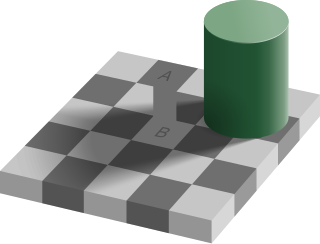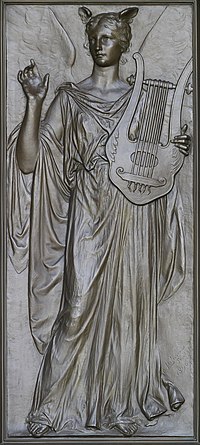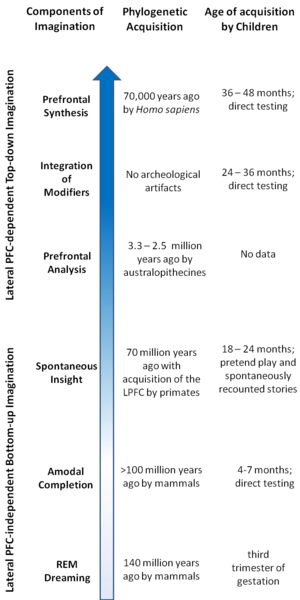Cognitive psychology is the scientific study of mental processes such as attention, language use, memory, perception, problem solving, creativity, and reasoning.

The mind is that which thinks, imagines, remembers, wills, and senses, or is the set of faculties responsible for such phenomena. The mind is also associated with experiencing perception, pleasure and pain, belief, desire, intention, and emotion. The mind can include conscious and non-conscious states as well as sensory and non-sensory experiences.

The philosophy of perception is concerned with the nature of perceptual experience and the status of perceptual data, in particular how they relate to beliefs about, or knowledge of, the world. Any explicit account of perception requires a commitment to one of a variety of ontological or metaphysical views. Philosophers distinguish internalist accounts, which assume that perceptions of objects, and knowledge or beliefs about them, are aspects of an individual's mind, and externalist accounts, which state that they constitute real aspects of the world external to the individual. The position of naïve realism—the 'everyday' impression of physical objects constituting what is perceived—is to some extent contradicted by the occurrence of perceptual illusions and hallucinations and the relativity of perceptual experience as well as certain insights in science. Realist conceptions include phenomenalism and direct and indirect realism. Anti-realist conceptions include idealism and skepticism. Recent philosophical work have expanded on the philosophical features of perception by going beyond the single paradigm of vision.

A cognitive bias is a systematic pattern of deviation from norm or rationality in judgment. Individuals create their own "subjective reality" from their perception of the input. An individual's construction of reality, not the objective input, may dictate their behavior in the world. Thus, cognitive biases may sometimes lead to perceptual distortion, inaccurate judgment, illogical interpretation, and irrationality.

Cognition is the "mental action or process of acquiring knowledge and understanding through thought, experience, and the senses". It encompasses all aspects of intellectual functions and processes such as: perception, attention, thought, imagination, intelligence, the formation of knowledge, memory and working memory, judgment and evaluation, reasoning and computation, problem-solving and decision-making, comprehension and production of language. Cognitive processes use existing knowledge and discover new knowledge.
Modularity of mind is the notion that a mind may, at least in part, be composed of innate neural structures or mental modules which have distinct, established, and evolutionarily developed functions. However, different definitions of "module" have been proposed by different authors. According to Jerry Fodor, the author of Modularity of Mind, a system can be considered 'modular' if its functions are made of multiple dimensions or units to some degree. One example of modularity in the mind is binding. When one perceives an object, they take in not only the features of an object, but the integrated features that can operate in sync or independently that create a whole. Instead of just seeing red, round, plastic, and moving, the subject may experience a rolling red ball. Binding may suggest that the mind is modular because it takes multiple cognitive processes to perceive one thing.
In the philosophy of mind, neuroscience, and cognitive science, a mental image is an experience that, on most occasions, significantly resembles the experience of "perceiving" some object, event, or scene but occurs when the relevant object, event, or scene is not actually present to the senses. There are sometimes episodes, particularly on falling asleep and waking up, when the mental imagery may be dynamic, phantasmagoric, and involuntary in character, repeatedly presenting identifiable objects or actions, spilling over from waking events, or defying perception, presenting a kaleidoscopic field, in which no distinct object can be discerned. Mental imagery can sometimes produce the same effects as would be produced by the behavior or experience imagined.

A mental model in psychology is an internal representation of external reality, hypothesized to play a major role in cognition, reasoning and decision-making. The term was coined by Kenneth Craik in 1943 who suggested that the mind constructs "small-scale models" of reality that it uses to anticipate events.
Auditory imagery is a form of mental imagery that is used to organize and analyze sounds when there is no external auditory stimulus present. This form of imagery is broken up into a couple of auditory modalities such as verbal imagery or musical imagery. This modality of mental imagery differs from other sensory images such as motor imagery or visual imagery. The vividness and detail of auditory imagery can vary from person to person depending on their background and condition of their brain. Through all of the research developed to understand auditory imagery behavioral neuroscientists have found that the auditory images developed in subjects' minds are generated in real time and consist of fairly precise information about quantifiable auditory properties as well as melodic and harmonic relationships. These studies have been able to recently gain confirmation and recognition due to the arrival of Positron emission tomography and fMRI scans that can confirm a physiological and psychological correlation.
The cognitive revolution was an intellectual movement that began in the 1950s as an interdisciplinary study of the mind and its processes, from which emerged a new field known as cognitive science. The preexisting relevant fields were psychology, linguistics, computer science, anthropology, neuroscience, and philosophy. The approaches used were developed within the then-nascent fields of artificial intelligence, computer science, and neuroscience. In the 1960s, the Harvard Center for Cognitive Studies and the Center for Human Information Processing at the University of California, San Diego were influential in developing the academic study of cognitive science. By the early 1970s, the cognitive movement had surpassed behaviorism as a psychological paradigm. Furthermore, by the early 1980s the cognitive approach had become the dominant line of research inquiry across most branches in the field of psychology.
Creative visualization is the cognitive process of purposefully generating visual mental imagery, with eyes open or closed, simulating or recreating visual perception, in order to maintain, inspect, and transform those images, consequently modifying their associated emotions or feelings, with intent to experience a subsequent beneficial physiological, psychological, or social effect, such as expediting the healing of wounds to the body, minimizing physical pain, alleviating psychological pain including anxiety, sadness, and low mood, improving self-esteem or self-confidence, and enhancing the capacity to cope when interacting with others.
Active imagination refers to a process or technique of engaging with the ideas or imaginings of one's mind. It is used as a mental strategy to communicate with the subconscious mind. In Jungian psychology, it is a method for bridging the conscious and unconscious minds. Instead of being linked to the Jungian process, the word "active imagination" in modern psychology is most frequently used to describe a propensity to have a very creative and present imagination. By examining the most evident manifestations of the unconscious mind—dreams—a person can learn how to execute this method on themselves. It is thought to be a crucial aid in the process of individuation. It employs creative imagination as an organ for "perceiving outside your mental boxes". For the first hundred years of active imagination, it was applied primarily by individuals for exploring their sub- and unconscious; hence its value in psycho-therapeutic settings. Until the "inner child" theme in the 1970s, active imagination was most closely associated with C. G. Jung's experiments with himself and with clients emphasizing its therapeutic value. In the 1980s, active imagination found uses in commercial disciplines, for example, architecture and molecular biology. Where active imagination seeks to perceive what is already present, fantasy intends to create where nothing yet exists.

Jean Decety is an American–French neuroscientist specializing in developmental neuroscience, affective neuroscience, and social neuroscience. His research focuses on the psychological and neurobiological mechanisms underpinning social cognition, particularly social decision-making, empathy, moral reasoning, altruism, pro-social behavior, and more generally interpersonal relationships. He is Irving B. Harris Distinguished Service Professor at the University of Chicago.
Motor imagery is a mental process by which an individual rehearses or simulates a given action. It is widely used in sport training as mental practice of action, neurological rehabilitation, and has also been employed as a research paradigm in cognitive neuroscience and cognitive psychology to investigate the content and the structure of covert processes that precede the execution of action. In some medical, musical, and athletic contexts, when paired with physical rehearsal, mental rehearsal can be as effective as pure physical rehearsal (practice) of an action.
Guided imagery is a mind-body intervention by which a trained practitioner or teacher helps a participant or patient to evoke and generate mental images that simulate or recreate the sensory perception of sights, sounds, tastes, smells, movements, and images associated with touch, such as texture, temperature, and pressure, as well as imaginative or mental content that the participant or patient experiences as defying conventional sensory categories, and that may precipitate strong emotions or feelings in the absence of the stimuli to which correlating sensory receptors are receptive.

Embodied cognition is the concept suggesting that many features of cognition are shaped by the state and capacities of the organism. The cognitive features include a wide spectrum of cognitive functions, such as perception biases, memory recall, comprehension and high-level mental constructs and performance on various cognitive tasks. The bodily aspects involve the motor system, the perceptual system, the bodily interactions with the environment (situatedness), and the assumptions about the world built the functional structure of organism's brain and body.
Fred W. Mast is a full professor of Psychology at the University of Bern in Switzerland, specialized in mental imagery, sensorimotor processing, and visual perception. He directs the Cognitive Psychology, Perception, and Research Methods Section at the Department of Psychology of the University of Bern.
Raymond W. Gibbs Jr. is a former psychology professor and researcher at the University of California, Santa Cruz. His research interests are in the fields of experimental psycholinguistics and cognitive science. His work concerns a range of theoretical issues, ranging from questions about the role of embodied experience in thought and language, to looking at people's use and understanding of figurative language. Raymond Gibbs's research is especially focused on bodily experience and linguistic meaning. Much of his research is motivated by theories of meaning in philosophy, linguistics, and comparative literature.
Aphantasia is the inability to create mental imagery.

Prefrontal synthesis is the conscious purposeful process of synthesizing novel mental images. PFS is neurologically different from the other types of imagination, such as simple memory recall and dreaming. Unlike dreaming, which is spontaneous and not controlled by the prefrontal cortex (PFC), PFS is controlled by and completely dependent on the intact lateral prefrontal cortex. Unlike simple memory recall that involves activation of a single neuronal ensemble (NE) encoded at some point in the past, PFS involves active combination of two or more object-encoding neuronal ensembles (objectNE). The mechanism of PFS is hypothesized to involve synchronization of several independent objectNEs. When objectNEs fire out-of-sync, the objects are perceived one at a time. However, once those objectNEs are time-shifted by the lateral PFC to fire in-phase with each other, they are consciously experienced as one unified object or scene.









